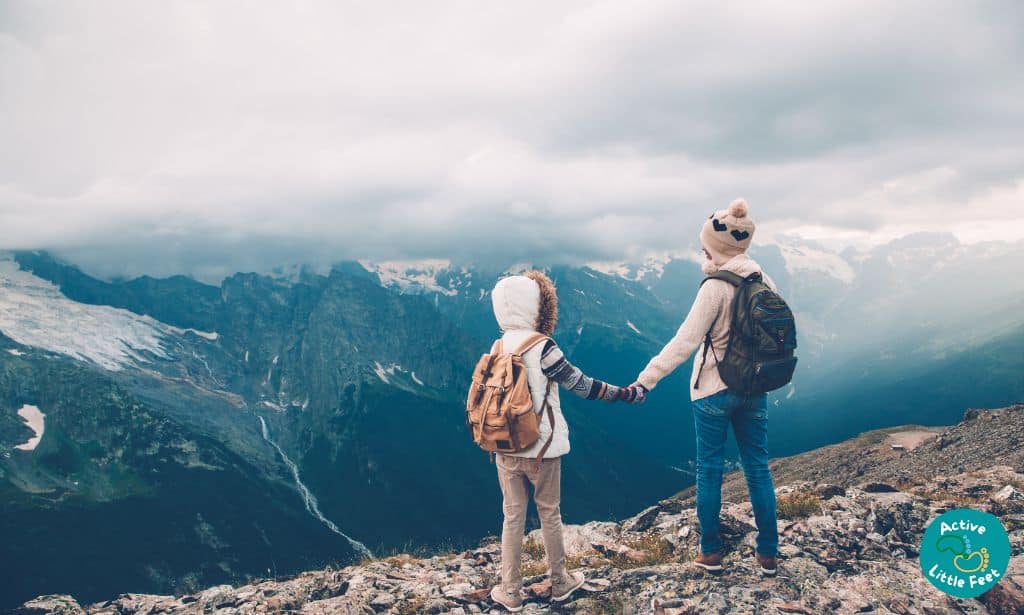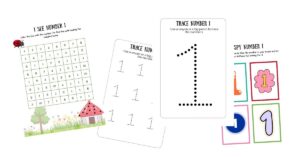The cold season is around the corner. And as we say goodbye to the beautiful fall and leaf activities, we are also excited for ski season, sledging and most especially, winter hiking. There’s no point staying indoors to nurse winter blues when you can go out and enjoy God’s creation.
The secret to enjoying all this, from our experience, has been keeping the kids warm. After all, there’s no such thing as bad weather, only unsuitable clothing, according to Alfred WainWright. If this will be your first time taking the little ones hiking in cold weather, this post is for you.
We’ve covered everything you need to know, from how to dress to what you must carry and even hiking tips.
Ready? See you on the flip side.
- Benefits of Hiking in Cold Weather
- When Can You Start Hiking With Kids in Cold Weather?
- How to Keep Kids Warm during a Winter Hike
- Other Items to Carry when Hiking with Kids in the Cold
- How to Carry the Kids when Hiking in Cold Temperatures
- Essential Items for Hiking in Cold Weather with Kids
- Basic Tips for Hiking with a Child in Cold Weather
Benefits of Hiking in Cold Weather
Hiking in winter is by no means easy, especially when you have kids. You need a lot more preparation than usual, and your luggage will be two times heavier. But if you ask me, the benefits far outweigh the effort, and this is why. We have more on reasons kids should hike here.
1. Nature Fights Off the Blues
The worst thing about the cold season is the winter blues. That feeling of staying in bed all day and watching sad soapies while the kids mope all day around the house. Time in nature is the best medicine against this sad situation because it boosts your happy hormones and significantly improves your mood. Even though it’s not possible to go hiking every day, those few days will help balance the good and the bad.
2. Encourages Bonding
Again, staying indoors means everyone locking themselves in the room or burying their heads in some gadget. But a hike encourages talking, laughing together, playing with ice and just overall bonding. These are the memories your kids will remember when they grow up, not the time in front of a TV.
3. Educational Benefits
Hiking in general is very educational. It teaches us about our environment, builds our endurance and encourages a love for nature. It’s an opportunity to teach your kids about many things when you are away from screens and distractions.
4. Physical Activity
The Department of Health requires children and teens to get 60 minutes of physical activity daily, no matter the weather. One way to get this is to take a literal hike. It will burn calories, boost immunity, build cardiovascular endurance, and improve overall energy. The time your kids spend playing on ice out there is very beneficial for their health.

When Can You Start Hiking With Kids in Cold Weather?
There’s no right age to start hiking with kids. However, we do recommend waiting until a baby’s neck is strong enough to stay up without support. This should be around month 4 or 5 when they start sitting up on their own, but you can do it at three months too.
This is also the age when their bowel movements have reduced in frequency, so you don’t have to change diapers every 30 minutes. Also, the younger a child is, the harder it is for them to regulate their body temperature, so exposing them to cold is not a good idea.
That said, we recommend starting slow with a walk around your neighborhood before moving to real hikes. You can read more on types of hikes here and how to choose the best for your kids. Give the baby time to build their immunity and get used to such extreme activities and also being carried for an extended period of time.
How to Keep Kids Warm during a Winter Hike
Now that you know the benefits of hiking with kids, even in cold weather, the main question is how to keep them warm throughout the hike. Kids have trouble regulating their body temperature, so the clothing you put on them must serve this purpose.
For that, you need a three-part layer to ensure the child is warm enough but not overheating.
1. Base Layer
The work of a base layer is to wick away moisture from the body and keep the baby warm. It should offer full body coverage (minus head and hands). We recommend merino wool for base layers, but a mixture of synthetics such as polyester will do.
Think of fleece pajamas or long-sleeve onesies paired with footed wool pants. The main thing here is to stay away from cotton because it absorbs moisture and holds on to it, which can make the child sick.
2. Mid Layer
The mid layer provides the warmth a child needs and it should also be full body. Here think of a fleece bunting suit with hand and foot covers. You can also do a knit woolen sweater and pants set and finish it with socks and gloves. Again, wool is preferred because of its warmth while cotton is still out.

3. Outer Layer
The last layer protects the child from elements such as rain, snow, wind, and moisture. You will therefore need water-resistant or water-proof and breathable fabrics.
An insulated head-to-toe snowsuit or water-proof bunting is excellent because it will keep the other layers safe. This is also the layer for water-proof boots and gloves because kids will play in the snow whether you like it or not.
Note: Feel free to leave some outer layer pieces out if you carry the baby on your body throughout the hike. Your body’s temperature is enough to keep the baby warm so you don’t need to overdress them. You can keep the hat, gloves, boots, and the first two layers.
Other Items to Carry when Hiking with Kids in the Cold
- Spikes. Ice cleats for older kids will be necessary if you are hiking on ice or snow surfaces, but they also come in handy if the terrain is wet, muddy or slippery. They will prevent unnecessary slips and falls and also make hiking easier for the child.
- Hand warmers/ heat bank. Keep a pack of hand warmers in the backpack, especially if the kids are under 5. Their tiny hands freeze faster and transfer the cold to the rest of the body.
- Neck gaiter, especially if you are hiking in a windy place.
- Goggles and sunscreen. Snow reflects sunlight, so you must protect their eyes and skin.
How to Carry the Kids when Hiking in Cold Temperatures
Choosing how you want to carry your kids to a hike depends on their age, the terrain and personal preference. For babies under two years old, your choices will be between a baby carrier, stroller and a sled. Older kids over two years could also use a sled or a stroller.
1. Wraps/slings
A baby wrap is a piece of fabric that wraps around your baby and secures them in various ways. They are the best option for infants because you can position the baby however you like and share your body warmth with them.
2. Carriers
Alternatively, you can use an already structured baby carrier to carry a baby. They are easy to use, provide multiple carrying options, and you can still share body warmth with the kid. On the downside, they are not easy to store when you take off the baby like a wrap.
3. Framed hiking packs
If your child is big (1-3 years), you can carry them around with a framed hiking pack instead of a carrier. The child gets to sit upright without feeling like a baby and you get extra storage for some items. However, they are cumbersome and bulky.
4. All-terrain Stroller
If hiking with the young one is something you want to do often, consider buying an all-terrain stroller. It features three large air-filled tires for better traction and provides space for your other luggage. A stroller takes the stress off your body, but it also limits how far you can go into the terrain.

Essential Items for Hiking in Cold Weather with Kids
These seven essentials will be necessary even if the weather is hot and kids do not accompany you. They may seem like a lot to carry but they are small in size and you can fit them all in your backpack.
1. Light Source
With cold weather comes darkness and fog, especially inside a forest or mountain area. A light source such as a flashlight or a headlamp will illuminate the paths when it gets dark and offer you peace of mind.
2. Compass
One thing I hate about hiking in cold weather is that it’s easy to lose your bearing. The snow and the darkness make it much harder to know where you are if you get sidetracked. Always carry a navigation tool that you can use, including a map and a compass.
3. First Aid Kit
Injuries and falls are things you should expect when hiking, especially when it’s wet or snowy. Always have a first aid kit to doctor any scrapes and bumps on yourself and the kids.
4. Fire Supply
The plan when hiking with kids is to stay a few hours and then go home. But in the rare occasion that something happens and you have to stay longer, a fire source will really help. You can light a fire to keep warm, cook food, or keep animals away.
5. Extra Food and Water
Hiking in the cold really works the body and, as a result, causes you to go hungry and thirsty faster. Ideally, you should pack food and liquids for the period you will be out there. However, always take precautions by carrying extras in case something happens and you are delayed, or the kids get hungry.
6. Trekking Poles
When we started hiking with kids, we would go to easy terrain areas and leave trekking poles behind. They seem like unnecessary baggage. Take it from me though, hiking with a child on your body and other luggage will make keeping your balance a lot harder. Trekking poles help with this and ensure you have a stable footing, so you don’t slip and fall.
7. Extra Clothes
Lesson number one when going anywhere with kids-always carry extra clothes and baby items. You need at least two spare clothes for when they get wet, puke all over themselves, fall in water or smear their clothes with mud. Pack extras of everything from main attire to socks, shoes and even the outer layer. While at it, carry extra diapers, disposable bags, wipes and warm water.

Basic Tips for Hiking with a Child in Cold Weather
1. Choose the right trail
As I said, hiking with kids requires more planning than usual, especially if it’s cold. You will need to plan your hiking route ahead of time to avoid trails that are too demanding to hike with kids or too dangerous.
Pick a trail that’s easy to navigate, safe for kids to walk through and preferably with good shade. This may mean going somewhere you have been before or looking for recommendations.
3. Time it right
Yes, timing matters when hiking with kids and when doing it in winter. For one, you need to time your hike when it’s a bit warm and bright outside. In many places, winter means shorter days and limited daylight.
If you have a baby, time the hike around nap time so they can sleep in the carrier. And if the child has a set naptime, avoid going hiking around that time and messing up their sleep schedule.
4. Have company
Perhaps this should be the number one advice for all hikers- do not go alone. Take a partner with you to help with the luggage, the baby and mental fatigue. They will also come in handy in the event of trouble.
5. Pack for you too
As with most occasions, moms pack everything for the kids and forget about themselves. Remember to put on your oxygen first. Pack your water, food, snacks, sunscreen and anything else you normally carry when hiking without kids.
6. Let the kids set the pace
If your kids are walking, allow them to set the hiking pace. Kids have shorter legs which means they walk slower and they get distracted faster. And since the idea of hiking with kids is for them to have fun, walk behind or beside them and allow them to lead the fun.
Your job is to show the way, teach where you can and experience their joy. If this means letting the kids make stopovers to explore a few things along the way, so be it. These hiking games for kids will also make hiking more fun for them.
Having small kids is no excuse to stop enjoying winter outdoor activities like hiking. In fact, kids tend to enjoy cold weather hikes and other activities even more than adults. And thankfully, they are resilient and open to enjoying and learning so much.
All you need is to dress them for warmth and pack all the essentials for winter hiking. More importantly, remember to have fun with each other. Hikes are about fun, not working out or getting tired.




